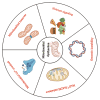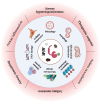Aryl hydrocarbon receptor: Linking environment to aging process in elderly patients with asthma
- PMID: 38238253
- PMCID: PMC10876263
- DOI: 10.1097/CM9.0000000000002960
Aryl hydrocarbon receptor: Linking environment to aging process in elderly patients with asthma
Abstract
Aging is a significant risk factor for various diseases, including asthma, and it often leads to poorer clinical outcomes, particularly in elderly individuals. It is recognized that age-related diseases are due to a time-dependent accumulation of cellular damage, resulting in a progressive decline in cellular and physiological functions and an increased susceptibility to chronic diseases. The effects of aging affect not only the elderly but also those of younger ages, posing significant challenges to global healthcare. Thus, understanding the molecular mechanisms associated with aging in different diseases is essential. One intriguing factor is the aryl hydrocarbon receptor (AhR), which serves as a cytoplasmic receptor and ligand-activated transcription factor and has been linked to the aging process. Here, we review the literature on several major hallmarks of aging, including mitochondrial dysfunction, cellular senescence, autophagy, mitophagy, epigenetic alterations, and microbiome disturbances. Moreover, we provide an overview of the impact of AhR on these hallmarks by mediating responses to environmental exposures, particularly in relation to the immune system. Furthermore, we explore how aging hallmarks affect clinical characteristics, inflammatory features, exacerbations, and the treatment of asthma. It is suggested that AhR signaling may potentially play a role in regulating asthma phenotypes in elderly populations as part of the aging process.
Copyright © 2024 The Chinese Medical Association, produced by Wolters Kluwer, Inc. under the CC-BY-NC-ND license.
Conflict of interest statement
None.
Figures






Similar articles
-
The Role of AhR in the Hallmarks of Brain Aging: Friend and Foe.Cells. 2021 Oct 13;10(10):2729. doi: 10.3390/cells10102729. Cells. 2021. PMID: 34685709 Free PMC article. Review.
-
Functions of the aryl hydrocarbon receptor (AHR) beyond the canonical AHR/ARNT signaling pathway.Biochem Pharmacol. 2023 Feb;208:115371. doi: 10.1016/j.bcp.2022.115371. Epub 2022 Dec 15. Biochem Pharmacol. 2023. PMID: 36528068 Free PMC article. Review.
-
The Role of the Aryl Hydrocarbon Receptor (AHR) in Immune and Inflammatory Diseases.Int J Mol Sci. 2018 Dec 3;19(12):3851. doi: 10.3390/ijms19123851. Int J Mol Sci. 2018. PMID: 30513921 Free PMC article. Review.
-
Type II alveolar epithelial cell aryl hydrocarbon receptor protects against allergic airway inflammation through controlling cell autophagy.Front Immunol. 2022 Jul 22;13:964575. doi: 10.3389/fimmu.2022.964575. eCollection 2022. Front Immunol. 2022. PMID: 35935956 Free PMC article.
-
Functions of the aryl hydrocarbon receptor in the skin.Semin Immunopathol. 2013 Nov;35(6):677-91. doi: 10.1007/s00281-013-0394-4. Epub 2013 Aug 16. Semin Immunopathol. 2013. PMID: 23949496 Review.
Cited by
-
Solute Carrier Family 26 Member 4 (SLC26A4), A Potential Therapeutic Target for Asthma.J Respir Biol Transl Med. 2024 Jun;1(2):10011. doi: 10.35534/jrbtm.2024.10011. Epub 2024 Jun 25. J Respir Biol Transl Med. 2024. PMID: 39100210 Free PMC article.
-
Aryl hydrocarbon receptor: current perspectives on key signaling partners and immunoregulatory role in inflammatory diseases.Front Immunol. 2024 Aug 15;15:1421346. doi: 10.3389/fimmu.2024.1421346. eCollection 2024. Front Immunol. 2024. PMID: 39211042 Free PMC article. Review.
-
Circadian rhythm and aryl hydrocarbon receptor crosstalk in bone marrow adipose tissue and implications in leukemia.Sci Rep. 2025 May 12;15(1):16387. doi: 10.1038/s41598-025-93169-0. Sci Rep. 2025. PMID: 40350529 Free PMC article.
-
Small proline-rich protein 2A drives epithelial remodeling in eosinophilic chronic rhinosinusitis with nasal polyps via SAA2 upregulation.J Allergy Clin Immunol. 2025 May 28:S0091-6749(25)00578-0. doi: 10.1016/j.jaci.2025.05.012. Online ahead of print. J Allergy Clin Immunol. 2025. PMID: 40447198
References
-
- de Almeida A de Almeida Rezende MS Dantas SH de Lima Silva S de Oliveira JCPL de Lourdes Assunção Araújo de Azevedo F, et al. . Unveiling the Role of Inflammation and Oxidative Stress on Age-Related Cardiovascular Diseases. Oxid Med Cell Longev. 2020;2020:1954398. doi: 10.1155/2020/1954398. - PMC - PubMed
-
- Rothhammer V, Quintana FJ. The aryl hydrocarbon receptor: an environmental sensor integrating immune responses in health and disease. Nat Rev Immunol. 2019;19:184–197. doi: 10.1038/s41577-019-0125-8. - PubMed

